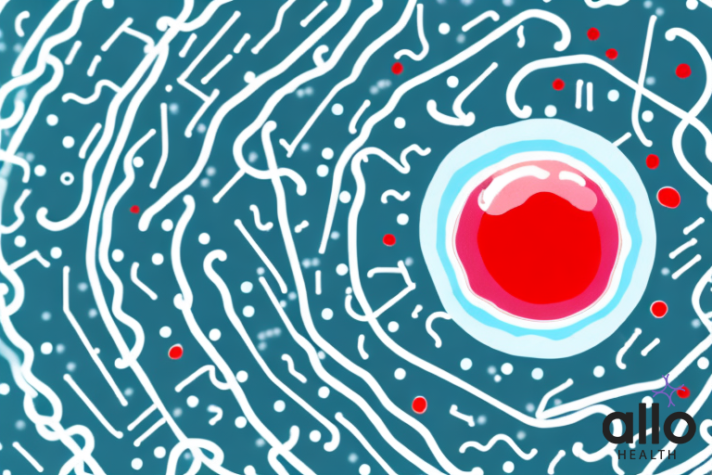Does Cephalexin Treat Gonorrhea and Chlamydia?

Allo Health is dedicated to personalized well-being, offering support and trusted information tailored to individual health goals. The platform emphasizes human-generated content, led by a distinguished medical team of experts, including physicians and sexual health specialists. Their commitment to credibility involves rigorous fact-checking, authoritative research, and continuous updates to ensure accurate, up-to-date information. Allo Health's unique approach goes beyond conventional platforms, providing expert-led insights and a continuous commitment to excellence, with user feedback playing a crucial role in shaping the platform's authoritative voice.

Dr Sanina Mansoor holds MBBS degree from Yenepoya university,Mangalore.She has 8 years of experience working as a medical officer at various health centres and medical colleges.
Why This Was Upated?
Our experts continually monitor the health and wellness space, and we update our articles when new information became available.
Updated on 19 February, 2024
- Article was updated as part of our commitment to diversity, equity, and inclusion.

"The following blog article provides general information and insights on various topics. However, it is important to note that the information presented is not intended as professional advice in any specific field or area. The content of this blog is for general educational and informational purposes only.
Book consultation
The content should not be interpreted as endorsement, recommendation, or guarantee of any product, service, or information mentioned. Readers are solely responsible for the decisions and actions they take based on the information provided in this blog. It is essential to exercise individual judgment, critical thinking, and personal responsibility when applying or implementing any information or suggestions discussed in the blog."
If you suspect that you might have Gonorrhea or Chlamydia, it’s natural to be curious about potential treatments. One medication that might come to mind is cephalexin. But does cephalexin actually treat these STIs?
What Is Cephalexin?
Cephalexin is an antibiotic medication that belongs to the cephalosporin class of drugs. It is commonly used to treat bacterial infections in various parts of the body. Here are some details about cephalexin:
- Mechanism of Action: Cephalexin works by inhibiting the synthesis of the bacterial cell wall. It does this by targeting and binding to specific proteins called penicillin-binding proteins (PBPs) that are involved in the construction of the bacterial cell wall. This disruption weakens the cell wall, ultimately leading to the death of the bacteria.
- Spectrum of Activity: Cephalexin is effective against a broad spectrum of bacteria, including both Gram-positive and some Gram-negative bacteria. It is commonly prescribed for infections caused by Staphylococcus aureus, Streptococcus pneumoniae, Escherichia coli, and other susceptible organisms.
- Indications: Cephalexin is prescribed for various infections, such as respiratory tract infections, skin and soft tissue infections, urinary tract infections, bone and joint infections, and certain types of otitis media (ear infections).
- Dosage: The dosage of cephalexin varies depending on the type and severity of the infection, as well as the patient’s age and overall health. It is usually taken orally in the form of capsules or liquid suspension.
- Administration: Cephalexin is typically taken with or without food, as directed by the healthcare provider. It is essential to complete the full course of treatment, even if symptoms improve before the medication is finished.
- Side Effects: Common side effects of cephalexin may include nausea, vomiting, diarrhea, and abdominal pain. Allergic reactions such as rash, itching, and swelling are possible but less common. It’s important to seek medical attention if any severe side effects occur.
- Precautions: Individuals with a known allergy to cephalosporins or penicillins should avoid cephalexin. It is crucial to inform the healthcare provider about any pre-existing medical conditions or medications being taken to avoid potential interactions.
- Pregnancy and Lactation: Cephalexin is generally considered safe to use during pregnancy and lactation, but it is essential for pregnant or breastfeeding women to consult with their healthcare provider before taking any medication.
- Resistance: Like other antibiotics, bacterial resistance to cephalexin can develop over time. It’s important to use the medication as prescribed and not misuse or overuse antibiotics to minimize the risk of resistance.
Always follow the specific instructions provided by your healthcare provider and consult them if you have any concerns or experience adverse effects while taking cephalexin.

Cephalexin Uses And Benefits
Cephalexin is a versatile antibiotic that is used to treat various bacterial infections. Its uses and benefits are detailed below:
- Respiratory Infections: Cephalexin is commonly prescribed for respiratory tract infections, including bacterial pneumonia, bronchitis, and infections of the throat and tonsils. It is effective against a range of bacteria that can cause respiratory concerns.
- Skin and Soft Tissue Infections: Skin infections, such as cellulitis and impetigo, as well as soft tissue infections, can be treated with cephalexin. It helps combat bacterial growth at the site of infection.
- Urinary Tract Infections (UTIs): Cephalexin is often used to treat uncomplicated urinary tract infections caused by susceptible bacteria. It can help alleviate symptoms such as frequent urination, pain, and discomfort.
- Otitis Media (Ear Infections): Certain types of ear infections, especially those caused by susceptible bacteria, can be treated with cephalexin. It is commonly prescribed for otitis media in both children and adults.
- Bone and Joint Infections: Infections affecting the bones and joints, such as osteomyelitis or septic arthritis, may be treated with cephalexin. It helps in eradicating the bacterial infection from these areas.
- Genitourinary Infections: Cephalexin is used for infections of the genital and urinary systems, including infections of the prostate gland and reproductive organs.
- Dental Infections: Dental abscesses and other bacterial infections in the oral cavity may be treated with cephalexin. It is sometimes used as part of dental prophylaxis in certain procedures.
- Streptococcal Infections: Cephalexin is effective against Streptococcus species, making it suitable for treating infections caused by these bacteria, such as strep throat.
- Surgical Prophylaxis: Cephalexin is sometimes prescribed before certain surgical procedures as a prophylactic measure to prevent bacterial infections.
- Prevention of Recurrent Urinary Tract Infections: In some cases, cephalexin may be prescribed for prophylactic use to prevent recurrent urinary tract infections in individuals who are prone to such infections.
- Community-Acquired Infections: Cephalexin is often chosen for the treatment of community-acquired infections due to its effectiveness against a wide range of bacteria commonly found in the community setting.
- Pediatric Infections: Cephalexin is generally considered safe for use in children and is prescribed for various bacterial infections in pediatric patients.
It’s important to note that while cephalexin is effective against many bacteria, it may not be appropriate for all types of infections, and the choice of antibiotic should be based on the specific bacteria causing the infection and its susceptibility to the medication. Always follow the guidance of a healthcare professional regarding the appropriate use of cephalexin and the duration of treatment.
Cephalexin Side Effects And Precautions
Cephalexin, like any medication, can have side effects, and certain precautions should be taken to ensure its safe use. Here are details about potential side effects and precautions associated with cephalexin:
Common Side Effects:
- Gastrointestinal Distress: Nausea, vomiting, diarrhea, and abdominal pain are among the common gastrointestinal side effects associated with cephalexin. Taking the medication with food or a snack can help alleviate these symptoms.
- Allergic Reactions: Allergic reactions, while less common, can occur. Symptoms may include skin rash, itching, swelling, severe dizziness, or difficulty breathing. Any signs of an allergic reaction should be reported to a healthcare professional promptly.
Serious Side Effects:
- Clostridium difficile Infection (CDI): Cephalexin use may lead to the overgrowth of Clostridium difficile bacteria, causing a severe form of diarrhea known as C. difficile-associated diarrhea (CDAD). If persistent diarrhea occurs, it’s important to seek medical attention.
- Severe Skin Reactions: Rare but serious skin reactions, such as Stevens-Johnson syndrome and toxic epidermal necrolysis, have been reported with the use of cephalexin. These can be life-threatening and require immediate medical attention.
- Hematologic Effects: Cephalexin may rarely affect blood cell counts, leading to conditions such as agranulocytosis or hemolytic anemia. Monitoring for any signs of blood disorders is important during treatment.
Precautions:
- Allergies: Individuals with a known allergy to cephalosporins or penicillin should avoid cephalexin. Cross-reactivity between these antibiotic classes can occur, and severe allergic reactions may result.
- Renal Impairment: Cephalexin is primarily excreted through the kidneys. Dosage adjustments may be necessary for individuals with renal impairment to prevent the accumulation of the drug in the body.
- Pregnancy and Lactation: While cephalexin is generally considered safe for use during pregnancy and lactation, it’s important for pregnant or breastfeeding women to consult with their healthcare provider before taking any medication.
- Drug Interactions: Cephalexin may interact with certain medications, including probenecid, which can increase cephalexin levels in the blood. Inform your healthcare provider about all medications, including over the counter and herbal supplements, before starting cephalexin.
- Diabetes: Cephalexin may interfere with certain diagnostic tests for diabetes, leading to false-positive results for urine glucose. Inform your healthcare provider if you are undergoing such tests.
- Bacterial Resistance: Like all antibiotics, the overuse or misuse of cephalexin can contribute to the development of bacterial resistance. It is crucial to complete the full course of treatment as prescribed by the healthcare provider.
- Caution in Pediatric Patients: While generally considered safe for use in children, cephalexin should be used with caution in infants and newborns. Dosage adjustments may be necessary based on weight and age.
It’s important to use cephalexin under the supervision of a healthcare professional who can assess individual health conditions and provide guidance on the appropriate dosage and duration of treatment. If any unusual or severe side effects occur, seek medical attention promptly.

Cephalexin Drug Interactions
Cephalexin, like many medications, can interact with other drugs, potentially affecting their effectiveness or leading to adverse effects. It’s crucial to inform your healthcare provider about all the medications, supplements, and herbal products you are taking to avoid potential drug interactions. Here are some details about drug interactions involving cephalexin:
- Probenecid: Probenecid, a medication used to treat gout, can reduce the elimination of cephalexin from the body. This can result in increased cephalexin levels in the blood, potentially leading to higher concentrations and an increased risk of side effects. Dosage adjustments may be necessary when these two drugs are used together.
- Metformin: Cephalexin may interfere with certain diagnostic tests for diabetes, leading to false-positive results for urine glucose. This interaction can occur with metformin, a medication commonly used to treat diabetes. Inform your healthcare provider if you are taking metformin or undergoing glucose tests while on cephalexin.
- Oral Contraceptives: There have been reports suggesting that antibiotics, including cephalexin, may reduce the effectiveness of oral contraceptives. Women using hormonal contraceptives should consider using additional methods of birth control while taking cephalexin.
- Anticoagulants (Blood Thinners): Cephalexin may enhance the effects of anticoagulant medications like warfarin, leading to an increased risk of bleeding. Close monitoring of blood clotting parameters is recommended when these drugs are used together.
- Loop Diuretics: Cephalexin may interact with loop diuretics (e.g., furosemide), potentially increasing the risk of nephrotoxicity (kidney damage). Monitoring kidney function is important when these drugs are used concurrently.
- Nephrotoxic Drugs: Cephalexin is excreted through the kidneys, and its elimination may be affected by other drugs that have nephrotoxic effects. Using cephalexin with other nephrotoxic drugs may increase the risk of kidney damage.
- Cholestyramine and Colestipol: Drugs like cholestyramine and colestipol, used to lower cholesterol, may reduce the absorption of cephalexin. These drugs should be taken at least 1 to 2 hours apart from cephalexin to avoid interference.
- Methotrexate: Cephalexin may increase the blood levels of methotrexate, a medication used for various conditions, potentially leading to methotrexate toxicity. Adjustments to methotrexate dosage and monitoring are necessary when used concurrently.
- Nonsteroidal Anti-Inflammatory Drugs (NSAIDs): Some NSAIDs, when used concurrently with cephalexin, may increase the risk of nephrotoxicity. Close monitoring of kidney function is advisable.
Always inform your healthcare provider about all the medications you are taking, including prescription drugs, over-the-counter medications, supplements, and herbal products. This information allows your healthcare provider to assess the potential for drug interactions and make appropriate adjustments to your treatment plan if necessary. If you have concerns about potential interactions, consult your healthcare provider for personalized advice.
Does Cephalexin Treat Gonorrhea and Chlamydia?
Cephalexin is not typically used as a first-line treatment for gonorrhea or chlamydia. These two sexually transmitted infections (STIs) are caused by different bacteria, and cephalexin may not be the most effective choice against them.
- Gonorrhea: Gonorrhea is caused by the bacterium Neisseria gonorrhoeae. The recommended treatment for uncomplicated gonorrhea usually involves antibiotics such as ceftriaxone or cefixime. These drugs are part of the cephalosporin class, similar to cephalexin but with a broader spectrum of activity against Neisseria gonorrhoeae.
- Chlamydia: Chlamydia is caused by the bacterium Chlamydia trachomatis. The recommended treatment for chlamydia is usually with antibiotics such as azithromycin or doxycycline. Cephalexin is not considered a first-line treatment for chlamydia, and its efficacy against Chlamydia trachomatis may be limited.
It’s important to note that the choice of antibiotics for treating STIs is guided by the specific bacteria causing the infection and their susceptibility to the drugs. In the case of gonorrhea and chlamydia, healthcare providers typically follow established guidelines to ensure the most effective treatment.
If you suspect you have an STI, it’s crucial to seek medical attention promptly. Your healthcare provider can perform the necessary tests to diagnose the infection and prescribe the appropriate antibiotics based on the specific bacteria involved. Additionally, it’s essential to inform your healthcare provider about any allergies or sensitivities to antibiotics that you may have.
Using the wrong antibiotic or not completing the prescribed course of treatment can lead to antibiotic resistance and may not effectively eliminate the infection. Always follow your healthcare provider’s guidance and complete the full course of antibiotics as prescribed.
Overview Of Gonorrhea and Chlamydia
Gonorrhea:
- Causative Agent: Gonorrhea is caused by the bacterium Neisseria gonorrhoeae.
- Transmission: Gonorrhea is primarily transmitted through sexual contact, including vaginal, oral, or anal sex with an infected person.
- Symptoms: Many individuals with gonorrhea may not exhibit any symptoms. When present, symptoms can include:
-
- Painful urination
- Abnormal discharge from the genitals (yellow or green)
- Pain or swelling in the testicles (in men)
- Pelvic pain (in women)
- Complications: If left untreated, gonorrhea can lead to serious health complications such as pelvic inflammatory disease (PID) in women, which can cause infertility. It can also increase the risk of ectopic pregnancies and facilitate the transmission of HIV.
- Diagnosis: Diagnosis is usually made through laboratory testing of samples taken from the site of infection (urine, swab from the genital or throat area).
- Treatment: The recommended treatment for uncomplicated gonorrhea involves antibiotics, typically a single dose of ceftriaxone, often combined with azithromycin to address possible co-infection with chlamydia.
Chlamydia:
- Causative Agent: Chlamydia is caused by the bacterium Chlamydia trachomatis.
- Transmission: Similar to gonorrhea, chlamydia is primarily transmitted through sexual contact. It can also be transmitted from an infected mother to her newborn during childbirth.
- Symptoms: Many individuals infected with chlamydia may not experience symptoms. When symptoms do occur, they can include:
-
- Abnormal discharge from the genitals
- Painful urination
- Lower abdominal pain (especially in women)
- Conjunctivitis (if the eyes are infected)
- Complications: If left untreated, chlamydia can lead to complications such as pelvic inflammatory disease (PID) in women, which may cause infertility. It can also increase the risk of ectopic pregnancies. In men, it can cause epididymitis.
- Diagnosis: Diagnosis is usually made through laboratory testing of samples taken from the site of infection (urine, swab from the genital or throat area).
- Treatment: Chlamydia is typically treated with antibiotics, such as azithromycin or doxycycline. It’s important to complete the full course of antibiotics as prescribed by a healthcare provider.
Prevention:
- Safe Sex Practices: Using condoms consistently and correctly during sexual activity can significantly reduce the risk of both gonorrhea and chlamydia.
- Regular Screening: Regular STI screenings, especially for individuals at higher risk, can help in early detection and treatment.
- Partner Communication: Open communication with sexual partners about STI testing and prevention is crucial for overall sexual health.
Both gonorrhea and chlamydia are treatable with appropriate antibiotics when diagnosed early. If you suspect you have been exposed to either infection or are experiencing symptoms, it is important to seek medical attention promptly for testing and treatment. Additionally, informing sexual partners and practicing safe sex are essential components of preventing the spread of these infections.
.
Most Asked Questions
-
Does Cephalexin Treat Gonorrhea?
Cephalexin is not the preferred treatment for gonorrhea. The recommended antibiotics for gonorrhea include ceftriaxone or cefixime. These drugs are more effective against Neisseria gonorrhoeae, the bacteria causing gonorrhea. If you suspect gonorrhea, consult a healthcare professional for appropriate testing and treatment.
-
Can Cephalexin Cure Chlamydia?
Cephalexin is not the first-line treatment for chlamydia. Chlamydial infections are typically treated with antibiotics like azithromycin or doxycycline. These medications are more specific to Chlamydia trachomatis. If you think you have chlamydia, seek prompt medical attention for accurate diagnosis and proper antibiotic treatment.
-
Why Isn't Cephalexin Used for Gonorrhea or Chlamydia?
Cephalexin belongs to the cephalosporin class of antibiotics and is effective against certain bacteria. However, it may not cover the specific strains of Neisseria gonorrhoeae or Chlamydia trachomatis, the causative agents of gonorrhea and chlamydia, as well as the recommended antibiotics. Using the appropriate antibiotics is crucial to ensure effective treatment.
-
What Happens If I Use Cephalexin for Gonorrhea or Chlamydia?
Using cephalexin for gonorrhea or chlamydia may not effectively clear the infections, leading to persistent symptoms and potential complications. It is essential to follow healthcare provider recommendations for the correct antibiotics to avoid the risk of antibiotic resistance and ensure successful treatment.
-
Can I Use Cephalexin If I'm Allergic to Recommended Antibiotics?
If you're allergic to recommended antibiotics for gonorrhea or chlamydia, consult your healthcare provider. Cephalexin may not be a suitable alternative, and your provider will determine an appropriate course of action based on your allergy profile and the specific bacteria causing the infection. Always communicate allergies to your healthcare provider for personalized and safe treatment.






































